Abstract
Sixteen strains of Escherichia coli serogroup O115 isolated from piglets with diarrhea were examined for mannose-sensitive or mannose-resistant hemagglutination (MSHA or MRHA, respectively) for the presence of fimbriae by electron microscopy and for enterotoxigenicity by the ligated gut loop technique in 10-day-old piglets. Four strains demonstrated MRHA of sheep, goat, pig, dog, cat, chicken, and human erythrocytes but no MRHA of calf, horse, guinea pig, and rabbit erythrocytes. They were divided into pattern I (MSHA negative) and pattern II (MSHA positive). The remaining 12 strains were classified as pattern III (MRHA negative, MSHA positive) and pattern IV (hemagglutination negative). An antiserum produced against the MRHA-positive, MSHA-negative strain 4787 and absorbed by the same strain grown at 15 degrees C agglutinated all of the MRHA-positive strains but none of the MRHA-negative strains and completely inhibited the MRHA of these strains. The surface antigen against which this absorbed antiserum was directed was designated "F165." Fimbriae (pili) purified from strain 4787 hemagglutinated erythrocytes in the same mannose-resistant pattern as the strain itself and reacted with the anti-F165 antiserum in an enzyme-linked immunosorbent assay, thus demonstrating the fimbrial nature of the hemagglutinating F165 antigen. The F165 antigen showed no serological relationship with the fimbrial antigens F4, F5, F6, and "F41". A positive correlation between the presence of F165 and the lack of enterotoxigenicity was demonstrated. Thus, we found a new mannose-resistant, hemagglutinating fimbrial antigen, F165, which is produced only by nonenterotoxigenic strains of E. coli serogroup O115. The possible role of F165 as a virulence attribute of E. coli strains causing extraintestinal disease is discussed.
Full text
PDF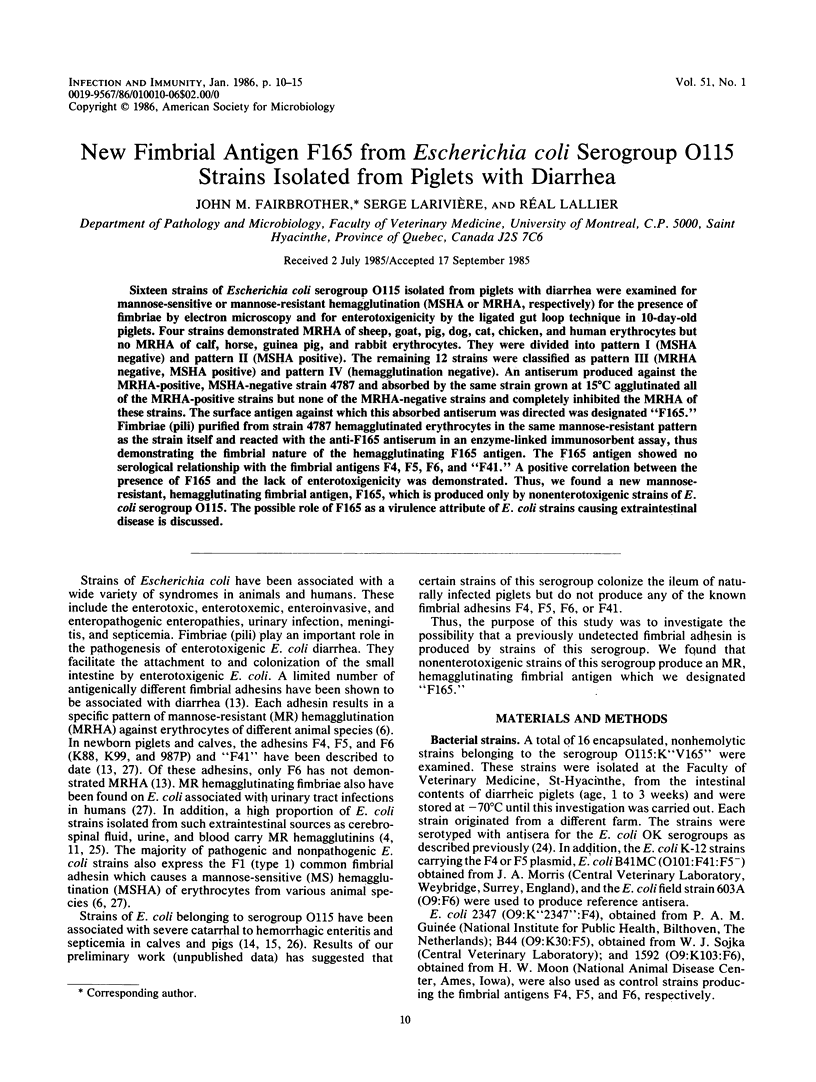
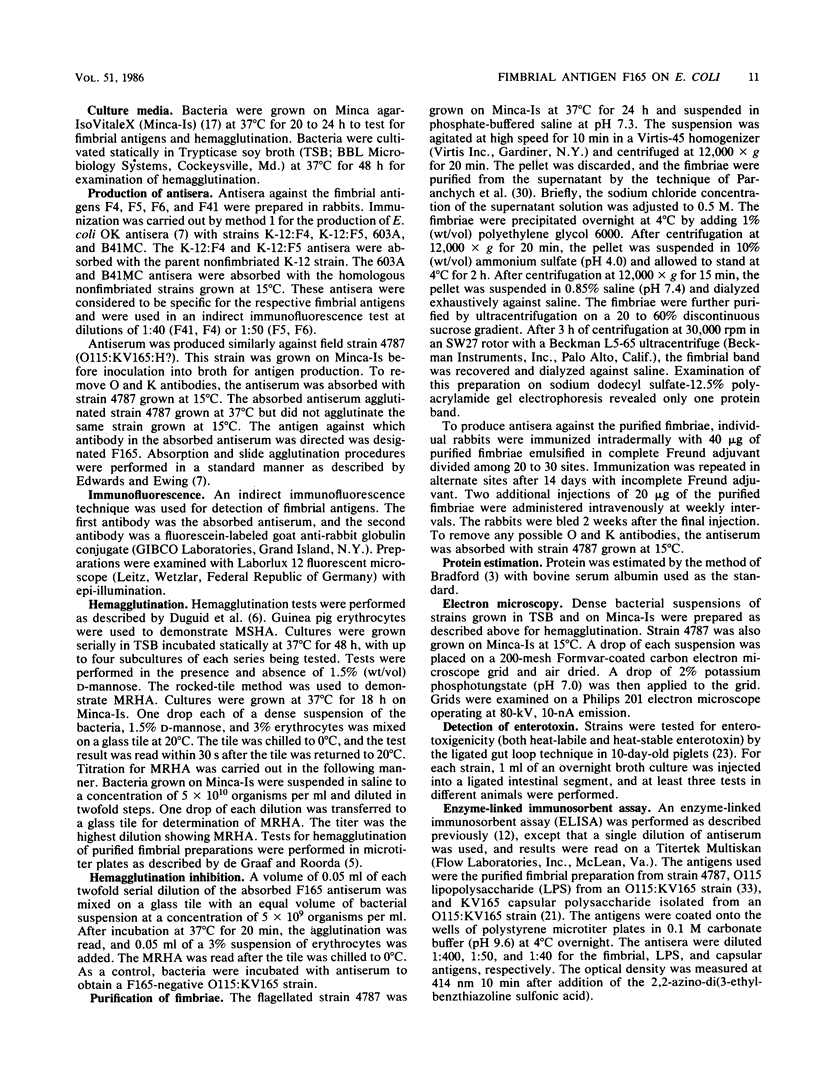
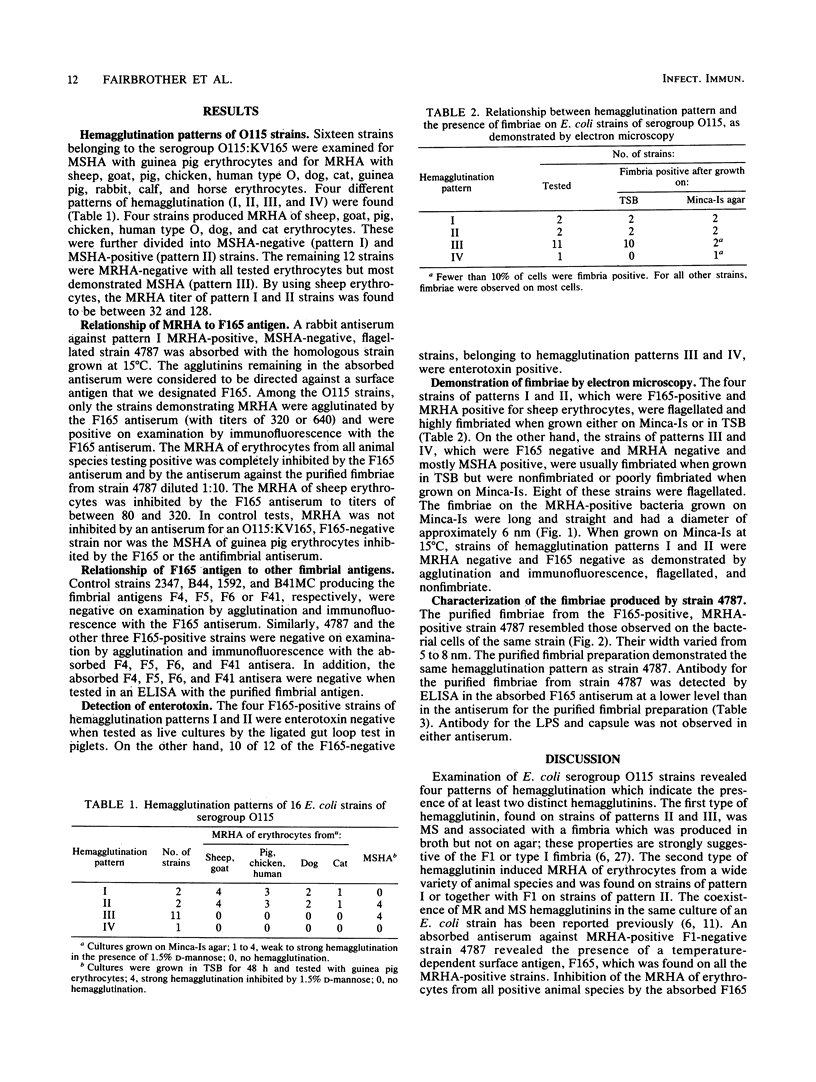
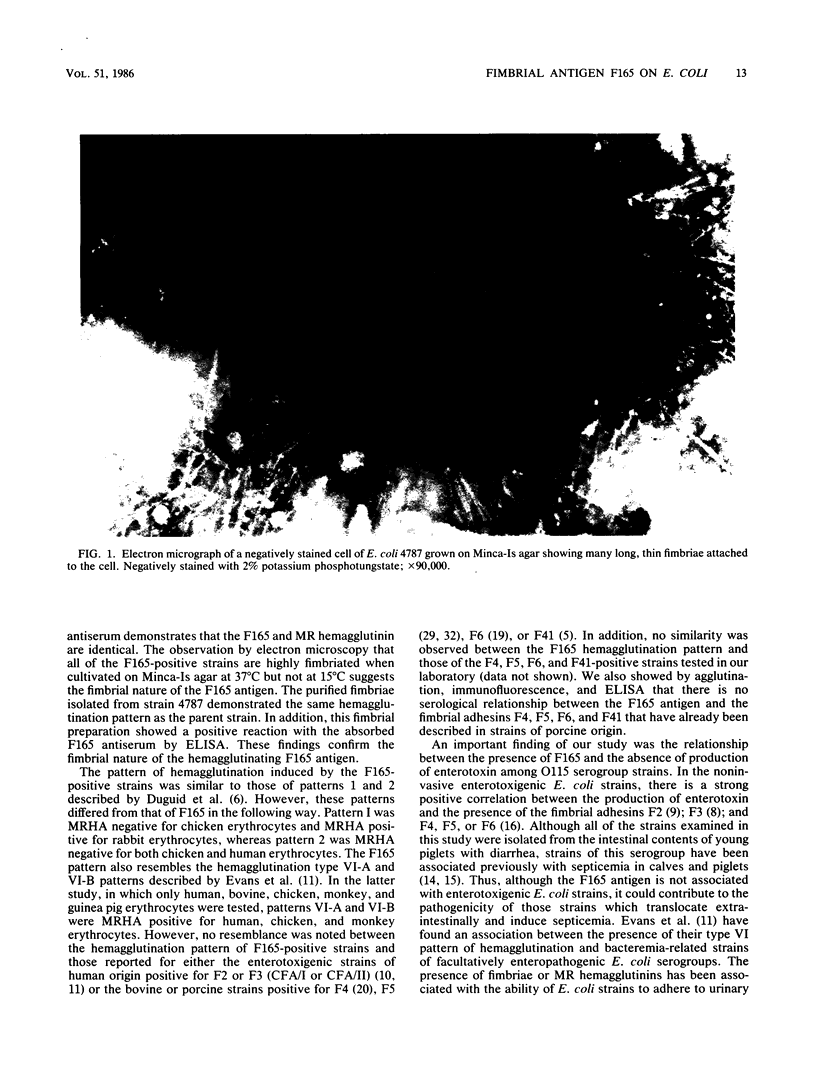
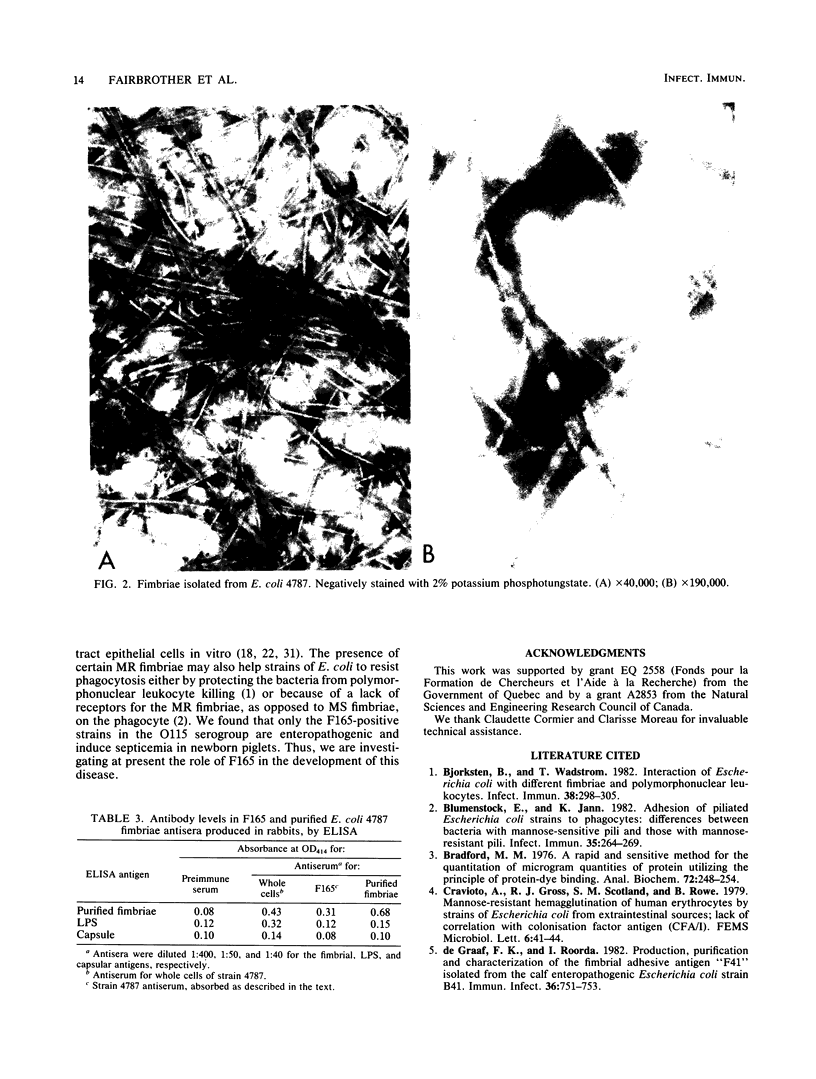
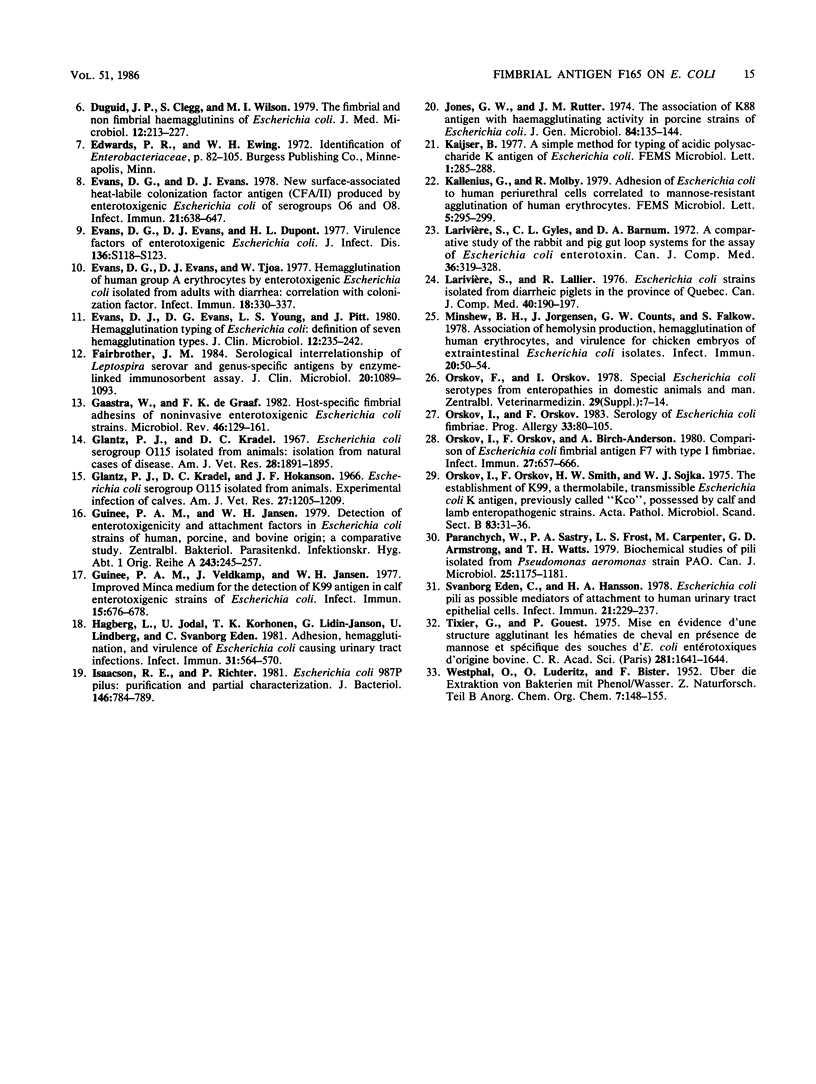
Images in this article
Selected References
These references are in PubMed. This may not be the complete list of references from this article.
- Björkstén B., Wadström T. Interaction of Escherichia coli with different fimbriae and polymorphonuclear leukocytes. Infect Immun. 1982 Oct;38(1):298–305. doi: 10.1128/iai.38.1.298-305.1982. [DOI] [PMC free article] [PubMed] [Google Scholar]
- Blumenstock E., Jann K. Adhesion of piliated Escherichia coli strains to phagocytes: differences between bacteria with mannose-sensitive pili and those with mannose-resistant pili. Infect Immun. 1982 Jan;35(1):264–269. doi: 10.1128/iai.35.1.264-269.1982. [DOI] [PMC free article] [PubMed] [Google Scholar]
- Bradford M. M. A rapid and sensitive method for the quantitation of microgram quantities of protein utilizing the principle of protein-dye binding. Anal Biochem. 1976 May 7;72:248–254. doi: 10.1006/abio.1976.9999. [DOI] [PubMed] [Google Scholar]
- Duguid J. P., Clegg S., Wilson M. I. The fimbrial and non-fimbrial haemagglutinins of Escherichia coli. J Med Microbiol. 1979 May;12(2):213–227. doi: 10.1099/00222615-12-2-213. [DOI] [PubMed] [Google Scholar]
- Edén C. S., Hansson H. A. Escherichia coli pili as possible mediators of attachment to human urinary tract epithelial cells. Infect Immun. 1978 Jul;21(1):229–237. doi: 10.1128/iai.21.1.229-237.1978. [DOI] [PMC free article] [PubMed] [Google Scholar]
- Evans D. G., Evans D. J., Jr, DuPont H. L. Virulence factors of enterotoxigenic Escherichia coli. J Infect Dis. 1977 Aug;136 (Suppl):S118–S123. doi: 10.1093/infdis/136.supplement.s118. [DOI] [PubMed] [Google Scholar]
- Evans D. G., Evans D. J., Jr New surface-associated heat-labile colonization factor antigen (CFA/II) produced by enterotoxigenic Escherichia coli of serogroups O6 and O8. Infect Immun. 1978 Aug;21(2):638–647. doi: 10.1128/iai.21.2.638-647.1978. [DOI] [PMC free article] [PubMed] [Google Scholar]
- Evans D. G., Evans D. J., Jr, Tjoa W. Hemagglutination of human group A erythrocytes by enterotoxigenic Escherichia coli isolated from adults with diarrhea: correlation with colonization factor. Infect Immun. 1977 Nov;18(2):330–337. doi: 10.1128/iai.18.2.330-337.1977. [DOI] [PMC free article] [PubMed] [Google Scholar]
- Evans D. J., Jr, Evans D. G., Young L. S., Pitt J. Hemagglutination typing of Escherichia coli: definition of seven hemagglutination types. J Clin Microbiol. 1980 Aug;12(2):235–242. doi: 10.1128/jcm.12.2.235-242.1980. [DOI] [PMC free article] [PubMed] [Google Scholar]
- Fairbrother J. M. Serological interrelationship of Leptospira serovar and genus-specific antigens by enzyme-linked immunosorbent assay. J Clin Microbiol. 1984 Dec;20(6):1089–1093. doi: 10.1128/jcm.20.6.1089-1093.1984. [DOI] [PMC free article] [PubMed] [Google Scholar]
- Gaastra W., de Graaf F. K. Host-specific fimbrial adhesins of noninvasive enterotoxigenic Escherichia coli strains. Microbiol Rev. 1982 Jun;46(2):129–161. doi: 10.1128/mr.46.2.129-161.1982. [DOI] [PMC free article] [PubMed] [Google Scholar]
- Glantz P. J., Kradel D. C. Escherichia coli serogroup 115 isolated from animals: isolation from natural cases of disease. Am J Vet Res. 1967 Nov;28(127):1891–1895. [PubMed] [Google Scholar]
- Guinée P. A., Jansen W. H. Detection of enterotoxigenicity and attachment factors in Escherichia coli strains of human, porcine and bovine origin; a comparative study. Zentralbl Bakteriol Orig A. 1979 Apr;243(2-3):245–257. [PubMed] [Google Scholar]
- Guinée P. A., Veldkamp J., Jansen W. H. Improved minca medium for the detection of K99 antigen in calf enterotoxigenic strains of Escherichia coli. Infect Immun. 1977 Feb;15(2):676–678. doi: 10.1128/iai.15.2.676-678.1977. [DOI] [PMC free article] [PubMed] [Google Scholar]
- Hagberg L., Jodal U., Korhonen T. K., Lidin-Janson G., Lindberg U., Svanborg Edén C. Adhesion, hemagglutination, and virulence of Escherichia coli causing urinary tract infections. Infect Immun. 1981 Feb;31(2):564–570. doi: 10.1128/iai.31.2.564-570.1981. [DOI] [PMC free article] [PubMed] [Google Scholar]
- Isaacson R. E., Richter P. Escherichia coli 987P pilus: purification and partial characterization. J Bacteriol. 1981 May;146(2):784–789. doi: 10.1128/jb.146.2.784-789.1981. [DOI] [PMC free article] [PubMed] [Google Scholar]
- Jones G. W., Rutter J. M. The association of K88 antigen with haemagglutinating activity in porcine strains of Escherichia coli. J Gen Microbiol. 1974 Sep;84(1):135–144. doi: 10.1099/00221287-84-1-135. [DOI] [PubMed] [Google Scholar]
- Larivière S., Gyles C. L., Barnum D. A. A comparative study of the rabbit and pig gut loop systems for the assay of Escherichia coli enterotoxin. Can J Comp Med. 1972 Oct;36(4):319–328. [PMC free article] [PubMed] [Google Scholar]
- Larivière S., Lallier R. Escherichia coli strains isolated from diarrheic piglets in the Province of Quebec. Can J Comp Med. 1976 Apr;40(2):190–197. [PMC free article] [PubMed] [Google Scholar]
- Minshew B. H., Jorgensen J., Counts G. W., Falkow S. Association of hemolysin production, hemagglutination of human erythrocytes, and virulence for chicken embryos of extraintestinal Escherichia coli isolates. Infect Immun. 1978 Apr;20(1):50–54. doi: 10.1128/iai.20.1.50-54.1978. [DOI] [PMC free article] [PubMed] [Google Scholar]
- Orskov I., Orskov F., Birch-Andersen A. Comparison of Escherichia coli fimbrial antigen F7 with type 1 fimbriae. Infect Immun. 1980 Feb;27(2):657–666. doi: 10.1128/iai.27.2.657-666.1980. [DOI] [PMC free article] [PubMed] [Google Scholar]
- Orskov I., Orskov F. Serology of Escherichia coli fimbriae. Prog Allergy. 1983;33:80–105. [PubMed] [Google Scholar]
- Orskov I., Orskov F., Smith H. W., Sojka W. J. The establishment of K99, a thermolabile, transmissible escherichia coli K antigen, previously called "Kco", possessed by calf and lamb enteropathogenic strains. Acta Pathol Microbiol Scand B. 1975 Feb;83(1):31–36. doi: 10.1111/j.1699-0463.1975.tb00066.x. [DOI] [PubMed] [Google Scholar]
- Paranchych W., Sastry P. A., Frost L. S., Carpenter M., Armstrong G. D., Watts T. H. Biochemical studies on pili isolated from Pseudomonas aeruginosa strain PAO. Can J Microbiol. 1979 Oct;25(10):1175–1181. doi: 10.1139/m79-182. [DOI] [PubMed] [Google Scholar]
- Tixier G., Gouet P. Mise en évidence d'une structure agglutinant les hématies de cheval en présence de mannose et spécifique des souches d'E. coli entérotoxiques d'origine bovine. C R Acad Sci Hebd Seances Acad Sci D. 1975 Nov 24;281(21):1641–1644. [PubMed] [Google Scholar]
- de Graaf F. K., Roorda I. Production, purification, and characterization of the fimbrial adhesive antigen F41 isolated from calf enteropathogenic Escherichia coli strain B41M. Infect Immun. 1982 May;36(2):751–758. doi: 10.1128/iai.36.2.751-758.1982. [DOI] [PMC free article] [PubMed] [Google Scholar]




